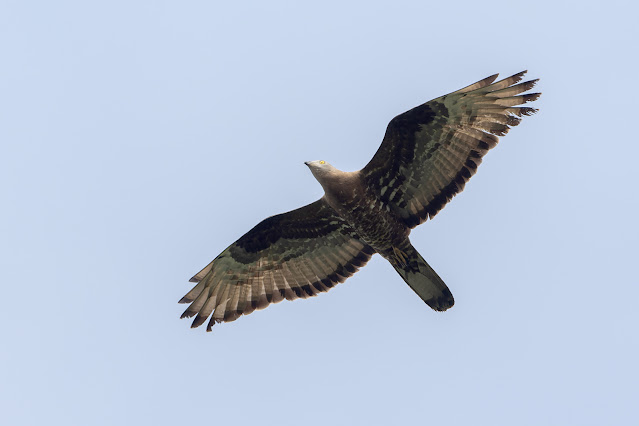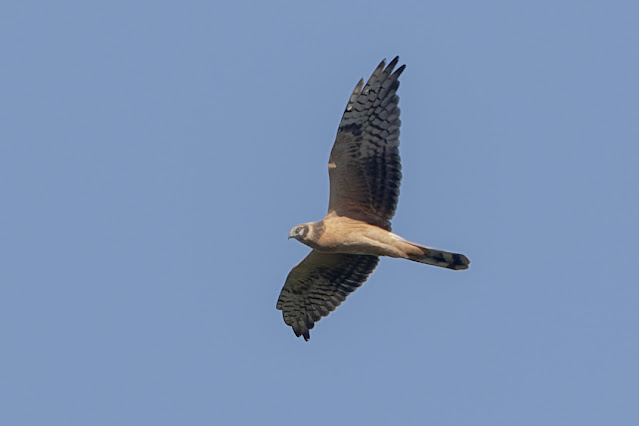A recent trip to Batumi in Georgia (which is written up below) provided a great opportunity to observe migrating harriers and to experience the difficulties of identifying them.
At some locations it is possible to have multiple sightings of the same bird, particular if you are visiting a breeding territory but on migration each bird typically passes you just once, and in the case of harriers this is usually quickly or very quickly! Consequently you have a short period of time in which to both identify and age each bird. Clearly this is assisted by taking photos and my first recommendation is to get photos of any harrier where its identity is uncertain.
We spent 11 days at Sakhalvasho and counted 242 harriers of which 23 were recorded as Pallid, 60 as Montagu's and 159 as Monpal (not specifically identified, either Pallid or Montagu's). Interestingly during those same 11 days the Batumi Raptor Count recorded 997 harriers with 63 Pallid, 362 Montagu's and 572 Monpal. I imagine we missed a large number of distant birds as, understandably, we were more interested in watching the closer birds and attempting to get photos.
I've gone through all my photos since returning home and consequently have changed the identity and/or age of some of the birds seen now that I have been able to look at them closely and review them against the literature and the large number of published photos, particularly on eBird.
I will not be addressing the separation of Pallid and Montagu's from Hen (or Northern) Harriers which is adequately covered elsewhere and given a decent view should not normally cause confusion although birds in moult can be a pitfall for the unwary.
Nor will I deal with adult males as again they are unlikely to be confused in even a half decent view.
My comments largely relate to birds in autumn although most of the identification criteria should apply at other times of the year.
Location and date are useful factors when dealing with a possible Pallid or Montagu's Harrier, in the UK a Monpal seen between October and April is very likely to be a Pallid Harrier. This is probably also the case for most of Northern Europe.
Below I have created montages of some of the birds seen and will go through the identification and ageing criteria I have used.
All the photos were taken at Batumi in September (unless stated otherwise), the light here is very variable and it was often very overcast quite unlike the conditions usually experienced in Southern Europe or the Middle East.
As a general comment I did not notice any structural or behavioural differences between the birds seen and do not think that size, shape or flight action are much help in identifying lone birds.
Pallid Harrier generally has a shorter outer primary (p10) than Montagu's but the difference does not appear to be sufficient to help in separating the two species.
Banding on the underside of the tail may provide additional support for the identification of both adults and juveniles. In female/juvenile Pallid the distal dark tail band is broad with a second band visible at the tip of the undertail coverts (PA1, PA3 and PJ4). In Montagu's the banding is slightly narrower with three bands visible between the undertail coverts and the tail tip (MA3, MJ3) but this feature should be used with caution.
Ageing and Sexing
The iris colour of juveniles is a safe means of separating males from females it is brown in females and yellow during a males first autumn.
Females in their second calendar year may still show a dark eye but some are already yellow eyed. The adult female Pallid PA1 is just showing a paler iris whilst the second calendar year Montagu's MA4 already has a bright yellow iris.
In the autumn of their second calendar year birds can be aged by the mix of adult and juvenile feathers.
Adult and Second Calendar Year Females
Recommended criteria, as marked on PA1 below;
 |
| Figure 1 Adult female and 2nd calendar year female Pallid v Montagu's Harrier |
a) Pattern and colouration of the secondaries
On adult female Montagu's there are at least two visible dark bars on the underside of the secondaries which are evenly spaced, and the pale area separating them continues to the birds body. In Pallid the distal dark bar often thickens towards the body causing the pale bar to narrow, often disappearing before it can meet the body.
In second calender year birds there may be a mix of new barred secondaries with older dark juvenile secondaries.
From above the secondary bars can be seen on Montagu's but not on Pallid and female Pallid shows some dark marks on the rump, as does the adult male, which is not shown by Montagu's.
 |
Pallid Harrier ad female note lack of obvious barring on the secondaries same as PA1 |
b) Primaries
On Montagu's the inner five primaries are dark tipped whereas these, particularly the inner 3 or 4, are pale like the rest of the feathers.
In second calendar year females the inner 7 or 8 primaries have usually been replaced by autumn leaving 2 or 3 outer primaries which are retained, worn, juvenile feathers.
c) Underwing coverts and axillaries
The axillaries on Montagu's are barred pale and dark brown or reddish brown and in adult females this pattern is repeated across the greater underwing coverts. An example of the longest axillary is inset by the carpal joint on figures MA1 and PA1.
The overall effect is often to create a strongly barred pattern in female Montagu's, MA4 is a good example. MA5 is a darker second calendar year bird and the darker 'armpit' is more akin to Pallid but note the axillary pattern is still Montagu's.
In Pallid these feathers are dotted rather than barred and the colouring tends to be more subdued although on reddish birds such as PA3 it can create a strong pattern which could be mistaken for that of Montagu's but a close look shows that these are discrete spots rather than bars.
Where the bars are not aligned it creates more of a chequer board effect as in Figure MA1.
d) Head pattern
The pale collar, which is a feature of juvenile Pallid harriers is retained in to adulthood by the female Pallid Harrier although it is not as obvious as in the juvenile but usually forms a crescent of even width behind the dark sickle shaped cheek surround.
There tends to be less contrast in female Montagu's head pattern the dark cheek surround is darkest behind the eye but tends to merge in to the dark neck colouration to the rear and below.
The dark head of MA5 is more Pallid like but there is less white in the sub-ocular area and there is no pale collar.
There is a lot of variation in the plumage of female Montagu's Harrier, in particular, and identification should be confirmed on a combination of features.
Juveniles
 |
| Figure 2 Juvenile Pallid and Montagu's Harriers |
Both species show dark tipped primaries but the dark area is much more extensive in Montagu's, often covering more than half the outer primaries, whilst it is generally just the tip in Pallid.
Given a decent view most female and juvenile Pallid and Montagu's Harriers should be identifiable.
Get a photo if possible and note the markings of the primaries, secondaries, underwing coverts and the head.
I've made no attempt to consider hybridisation which is known to have occurred between Hen and Pallid Harriers and Montagu's and Pallid Harriers.
I have produced a single sheet key to harrier identification which I've reproduced here;
 |
| Simplified key to harrier identification |
References
Forsman D, (2016)
Flight Identification of Raptors of Europe, North Africa and The Middle East
Forsman D, Dutch Birding 17:41-54, April 1995
Field identification of female and juvenile Montagu's and Pallid Harriers
Dobler G, (2022)
Field identification of the Hen Harrier, Montagu's Harrier and Pallid Harrier






















































